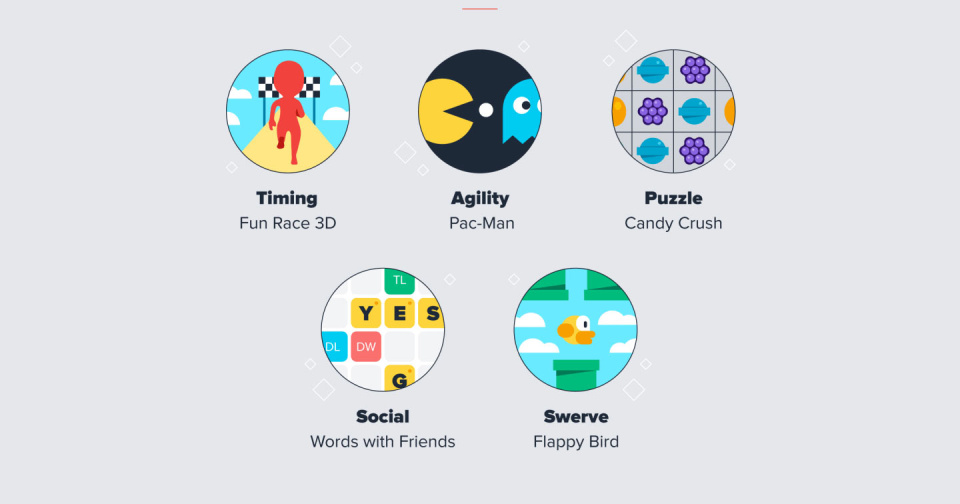In recent years, the landscape of mobile gaming has undergone a remarkable transformation. Gone are the days of easily classifying games into distinct genres like puzzle or strategy.
The emergence of hybrid casual mobile games, which combine elements from multiple genres to create entirely new gameplay experiences, has reshaped the industry.
This article serves as a comprehensive guide to developing a successful hybrid game, exploring the mechanics, pros and cons, popular fusions, and crucial steps for developers.
By following this step-by-step approach, developers can navigate the complexities of genre-blending, optimize user experience, and effectively market their games to stand out in the competitive mobile gaming market.

Table of Contents
Unveiling the Mechanics of Hybrid Games: Blending Genres for Engaging Experiences
At the core of hybrid casual games is the seamless integration of multiple genres. Instead of simply switching between disparate gameplay styles, these games employ a more advanced approach.
One genre takes the lead, forming the foundation of the game, while elements from another genre are introduced as a meta layer.
This blending of genres has found particular popularity within the casual gaming category, as developers combine hyper casual gameplay mechanics with meta mechanics borrowed from mid-core games.
Within hybrid casual games, several popular meta elements have emerged. The collectible meta allows players to amass stickers, characters, or items, providing a sense of progression and reward.
The RPG meta deepens the casual gaming experience by enabling players to upgrade equipment, enhance characters, and unlock new abilities.
Light construction and customization meta layers are common in match-3 games, offering opportunities for players to personalize their in-game spaces or showcase their fashion sense.
Finally, the narrative meta adds an extra layer of immersion, captivating players with compelling stories that keep them engaged.
The allure of hybrid casual games lies in their ability to break free from traditional genre boundaries, offering players a fresh and diverse gaming experience.
By blending genres and incorporating meta elements, these games provide a fusion of mechanics that cater to a broader range of player preferences.
In the following sections, we will delve deeper into each of these meta elements, exploring their advantages and applications, and showcasing notable examples of successful hybrid games that have embraced these mechanics.

Pros and Cons of Hybrid Mobile Games: Exploring the Benefits and Challenges
Hybrid casual mobile games have gained significant popularity, thanks to their ability to combine different genres and offer unique gaming experiences.
As with any innovation, there are pros and cons associated with this approach. In this section, we will examine the advantages and challenges of hybrid mobile games, providing insights into their impact on player engagement, user retention, and market competition.
One of the significant advantages of hybrid casual games is their potential to attract a wider player base. By blending genres, these games can appeal to players who have diverse gaming preferences.
For instance, a puzzle hybrid casual game with mid-core elements can simultaneously engage RPG enthusiasts, casual players, and puzzle aficionados. This broader appeal opens up new opportunities to reach and captivate a larger audience.
Additionally, blending genres allows developers to leverage the strengths of each genre while minimizing their weaknesses.
By capitalizing on the unique advantages of different genres, game creators can create more engaging experiences.
The inclusion of additional goals, progression loops, and diverse gameplay mechanics enhances player engagement, leading to longer playtimes and increased monetization opportunities.
Furthermore, hybrid casual games address the challenge of user retention often faced by casual and hyper-casual games. By providing additional content and gameplay elements, these games combat player churn.
For example, a merge hybrid casual game with mid-core elements offers addictive merge mechanics alongside item upgrades and building activities. This multifaceted gameplay encourages players to return to the game repeatedly, boosting user retention.
Another advantage of hybrid games is the reduced development risk compared to creating games within a single genre.
By combining proven mechanics from different genres, developers can mitigate the risk of creating a game that may not resonate with the target audience.
The incorporation of familiar gameplay elements, such as match-3 mechanics in a strategy game or character upgrades in an adventure game, provides a sense of familiarity while introducing new elements.
However, hybrid game development also presents challenges that developers need to navigate. One such challenge is striking the right balance between the core gameplay and the meta mechanics.
It is crucial to ensure that both aspects are distinct from one another, as this can lead to a disjointed player experience.
Achieving a harmonious balance requires thorough testing, iteration, and player feedback to fine-tune the game mechanics.
Another challenge lies in designing engaging content that sustains player interest. Hybrid games should offer a constant stream of new content, including levels, challenges, characters, items, and narrative elements.
This requires a creative and iterative approach to content creation, ensuring that players have ample reasons to continue exploring different aspects of the game.
Additionally, monetization in hybrid casual games must be approached thoughtfully.
Developers should implement effective monetization strategies that align with the hybrid nature of the game.
Balancing revenue generation with providing value to players is crucial to avoid hindering the overall gameplay experience.
Careful consideration of monetization models, such as in-app purchases, ads, or subscriptions, should be undertaken to ensure a fair and enjoyable experience for players.

Step-by-Step Guide to Developing a Successful Hybrid Game
Step 1: Identify the Target Audience
Before diving into development, it is essential to identify the target audience for your hybrid game. Understanding their preferences, demographics, and gaming habits will help you shape the game mechanics, content, and marketing strategies to resonate with your intended players.
Conduct market research, analyze player trends, and gather insights to inform your decisions throughout the development process.
Step 2: Define Core Gameplay and Genre Fusion
The first step in creating a successful hybrid game is to decide on the core genre that will drive the gameplay experience.
Consider the strengths and mechanics of different genres and select the one that aligns with your target audience’s preferences. Once the core genre is established, determine how the elements of the secondary genre will complement and enhance it.
This fusion of genres will set the tone for the entire development process.
Step 3: Design Meta Mechanics
Identify the meta mechanics from the secondary genre that will add depth and progression to your game. Consider elements such as character upgrades, item collection, customization options, narrative elements, or social features.
These meta mechanics should seamlessly integrate with the core gameplay, providing additional layers of engagement and reward for the players. Thoroughly plan and design these mechanics to ensure they enhance the overall player experience.
Step 4: Balance Gameplay Elements
Achieve a harmonious balance between the core gameplay and the meta mechanics.
Test and iterate to find the right blend of challenge, progression, and satisfaction for your players. Avoid overwhelming players with complex mechanics or diluting the core gameplay experience with excessive meta elements.
Continuously gather feedback from play testers and make adjustments to strike a balance that keeps players engaged and excited.
Step 5: Create Engaging Content
Develop compelling and diverse content to keep players engaged and invested in your game. This includes designing levels, challenges, characters, items, and narrative elements.
Strive to provide a constant stream of new content to maintain player interest and encourage them to explore different aspects of the game.
Regular content updates and events can help retain existing players and attract new ones.
Step 6: Polish User Experience
Focus on delivering a seamless and intuitive user experience. Pay attention to user interface design, controls, and overall accessibility.
Streamline the gameplay flow and ensure that players can easily navigate between different mechanics and features. Conduct thorough playtesting to identify any usability issues and make necessary improvements.
Continuously refine the user experience based on player feedback and iterate to create a polished and enjoyable gameplay experience.
Step 7: Test and Refine
Conduct rigorous testing to identify and address any gameplay issues, bugs, or imbalances. Gather feedback from play testers and iterate based on their input.
Continuously refine and optimize your game to provide the best possible experience for your players. Test on different devices and operating systems to ensure compatibility and performance across a wide range of platforms.
Step 8: Implement Effective Monetization Strategies
Consider various monetization models that align with the hybrid nature of your game. Evaluate options such as in-app purchases, ads, or subscriptions to generate revenue.
However, it is crucial to integrate monetization mechanics thoughtfully, ensuring they do not hinder the overall gameplay experience. Strike a balance between generating revenue and providing value to your players, offering optional purchases or rewards that enhance their gameplay experience.
Step 9: Develop a Comprehensive Marketing Plan
Craft a comprehensive marketing strategy to promote your hybrid game and reach your target audience. Identify key selling points and unique features of your genre fusion.
Utilize social media, app stores, influencers, and other relevant channels to target and engage potential players. Create engaging promotional materials, including screenshots, videos, and descriptions that highlight the innovative gameplay and mechanics of your hybrid game.
Build anticipation leading up to the game’s release through teasers, beta testing, and community engagement.
Step 10: Monitor and Iterate
Once your game is launched, closely monitor player feedback, analytics, and market trends. Continuously update and improve your game based on user insights, fix any issues, and introduce new content to keep players engaged and attract new ones.
Stay responsive to player demands and adapt your game to evolving market trends. Regularly evaluate the performance of your game, and track user retention, engagement metrics, and revenue generation to make informed decisions for future updates and expansions.

The world of hybrid casual mobile games offers immense potential for developers to create captivating and innovative experiences for players.
By blending genres and incorporating meta mechanics, developers can appeal to a broader audience and offer engaging gameplay that transcends traditional genre boundaries.
However, the development of successful hybrid casual games requires careful planning, execution, and attention to detail.
By following a step-by-step guide that includes identifying the target audience, defining core gameplay, designing meta mechanics, balancing gameplay elements, creating engaging content, polishing user experience, testing, and refining, implementing effective monetization strategies, developing a comprehensive marketing plan, monitoring, and iterating, developers can increase their chances of creating a successful hybrid game that resonates with players and stands out in the competitive mobile gaming market.
Embrace the possibilities of hybrid game development and unlock the potential for endless creativity and player engagement.
